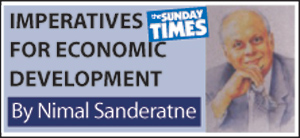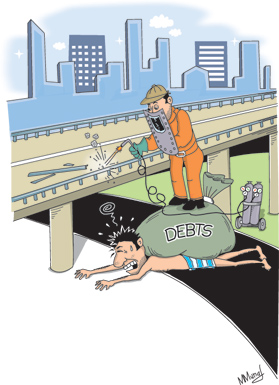Columns
Benefits and costs of economic infrastructure development
View(s):The development of the country’s physical infrastructure has been a striking achievement in the post-war period. Improvement and development of the road network, increasing power generation, the construction of bridges, development of ports and the improvement of railways have been an important aspect of economic development in the last four years.

This is in contrast to much of the deterioration in economic infrastructure since the 1960s. Financial constraints, the nearly three decades of terrorism and the war aggravated the neglect of infrastructure.
Finances had to be diverted to these and consequently capital expenditure for maintenance and development of infrastructure was curtailed. In fact even some of the existing infrastructure was destroyed during the war years.
While there had been impressive gains in economic infrastructure, one cannot necessarily claim a similar achievement in as far as social infrastructure is concerned.
The costly development of infrastructure has also raised concerns regarding the impact of such expenditure on the economy. The selection of some massive infrastructure projects is of doubtful priority and their benefits uncertain in the foreseeable future. One can hope that at least in the long-run, these large investments already completed will make a significant contribution to the country’s economy.
Past neglect
At the time of independence, Sri Lanka had a fairly well developed infrastructure. The railways were extensive and efficient. The road density and the quality of roads were impressive for that time. The Colombo port was one of the world’s busy ports. However, after the first decade or two of independence, the economic strains arising from the adverse terms of trade, internal conflicts and inappropriate economic policies led to a situation when the public finances of the country did not permit adequate investment in infrastructure development. The constraints in public finance resulted in a reduction in capital expenditure to cope with increasing fiscal deficits.
In the post-liberalisation period since 1978, there was an improvement in infrastructure development, especially the development of irrigation and the hydro-electricity generation capacity of the Accelerated Mahaweli Development Programme. This new thrust in infrastructure development was arrested by the setback to the economy owing to the aftermath of the July 1983 ethnic disturbances, the surging terrorism and the subsequent expensive and disruptive war. The Southern insurgency in 1988/89 compounded the problem.
These factors arrested the initial prospects of rapid economic growth and diverted public expenditure to the war effort. Economic and social infrastructure development was neglected.
Post-war development
The end of the war gave a new impetus for the development of infrastructure. Although the finances of the country were by no means healthy, the Government had a vision to improve the country’s neglected and devastated infrastructure. It is to the credit of the Government that despite the fiscal difficulties, expenditure on infrastructure development was not curtailed. Capital expenditure absorbed about 5 per cent of GDP.

The result was that roads were improved, new highways developed, the rolling stock improved, bridges constructed and some irrigation networks improved. The reconstruction of the devastated North and East has also been a significant achievement. The Colombo port has been impressively developed, the Hambantota port immensely expanded and a second international airport constructed.
Another fascinating facet of Sri Lanka’s infrastructure development has been the beautification of Colombo and its suburbs — Rajagiriya- Sri Jayawardenepura. No one can be unimpressed with the development of recreational facilities; restoration of old neglected buildings such as the Colombo race course stadium and the impressive restoration of the Dutch hospital in the Fort. These are but a few examples of a wide array of impressive infrastructure developments that have improved the beauty and quality of life in the city.
Costs and benefits
Despite these benefits, there are emerging concerns about the vast expenditure on this impressive infrastructure development. Even if we assume that these investments on infrastructure would benefit the economy, its huge initial expenditure and long periods of gestation raises critical economic concerns.
The immediate burden of huge investments creates strains in the public finances resulting in large fiscal deficits that lead to large public debt. Unfortunately, a huge public debt had been generated over several decades first by large investment programmes, most notably the Accelerated Mahaweli Development Programme and the war expenditure. Consequently, the additional expenditure on infrastructure development in the last four years has been an important factor in increasing the public debt and the debt servicing cost that had been discussed in previous columns.
This concern makes it necessary to select infrastructure development on a priority basis. Those infrastructure developments, which bear fruit in a shorter period should be mixed with important infrastructure development that brings returns over a long period of time. Infrastructure developments that are of doubtful returns or ones that bring returns over a long period should be avoided till such time as the country’s economy could afford them. There is a public concern that several of the large investments in infrastructure have been too costly and of doubtful economic benefit.
Conclusion
The country’s economic infrastructure has been developed and updated in the past four years. There will no doubt be economic and social benefits from many of these in the fullness of time. Nevertheless, huge expenditures on infrastructure tend to be a strain on the public finances and threaten economic stability. It is, therefore, vital that in future programmes of infrastructure development, consideration should be given to investments with a shorter period of gestation and have a more direct impact on production: ones that either save import expenditure or enhance export earnings and are of economic and social priority. In the case of huge investments that may take a long time to benefit, one hopes that the burden of debt they require to pay would be lightened by benefits of these in the future.
The gains in social development were impressive in the first three decades after independence owing to significant public expenditure on education, health and nutrition. The country may have reached a point in time when we can decelerate expenditure on economic infrastructure and channel more funds towards the development of social infrastructure: health, education and social welfare.
comments powered by Disqus
